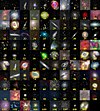30 Doradus
| Emission nebula | |
|---|---|
| Dates of the tarantula nebula (30 Doradus)
|
|

|
|
| The tarantula nebula captured by the Hubble Space Telescope | |
| AladinLite | |
| Constellation | Swordfish |
|
Position equinox : J2000.0 , epoch : J2000.0 |
|
| Right ascension | 05 h 38 m 42.3 s |
| declination | -69 ° 06 ′ 03 ″ |
| Appearance
|
|
| Apparent brightness (visual) | 8.0 likes |
| Apparent brightness (B-band) | 5.0 likes |
| Angular expansion | 30 '× 20' |
| Ionizing source | |
| Physical data
|
|
| distance | 179,000 ly (52,000 pc ) |
|
history
|
|
| discovery | Nicolas Louis de Lacaille |
| Date of discovery | 1751 |
| Catalog names | |
| NGC 2070 • GC 1269 • h 2941 • ESO 57-EN6 | |
30 Doradus (also Tarantula Nebula or NGC 2070 ) is the name of a very bright emission nebula located in the Large Magellanic Cloud in the constellation Swordfish (Dorado) . It is one of the largest known star formation regions in the local group and, despite its distance of 179,000 light years (52 kpc), can be seen in small telescopes. It has a diameter of 30 '× 20' (which corresponds to ≈2000 light years) and an apparent magnitude of 8.0 mag.
30 Doradus was discovered in 1751 by the French astronomer Nicolas Louis de Lacaille , who gave it a star number (30). John Herschel referred to it as the looped nebula because of the turbulence visible in the telescope .
The star cluster R136 embedded in the center excites the entire nebula complex to glow. It contains the most massive and brightest known star R136a1 (265 M☉, 10 7 L☉) and two other stars with over 150 solar masses .
In the northern part of the Tarantula Nebula there is also the double cluster Hodge 301 . Some of its giant stars also illuminate the surrounding nebula, but at 25 million years it is much older than R136.

See also
Web links
- Hubble Space Telescope
- The tarantula nebula . Spitzer Space Telescope (tarantula nebula image from the Spitzer Space Telescope)
- 30Doradus.org
- Photo from ESO
- 30 Doradus / WFI Data Release: Version 1.0
- Spektrum.de : Collection of amateur recordings
Individual evidence
- ↑ NASA / IPAC EXTRAGALACTIC DATABASE
- ^ A b c Students for the Exploration and Development of Space
- ↑ SEDS: NGC 2070
- ↑ Seligman
- ↑ Axel Quetz: Heaven and Earth , May 2013, Verlag Sterne und Weltraum
